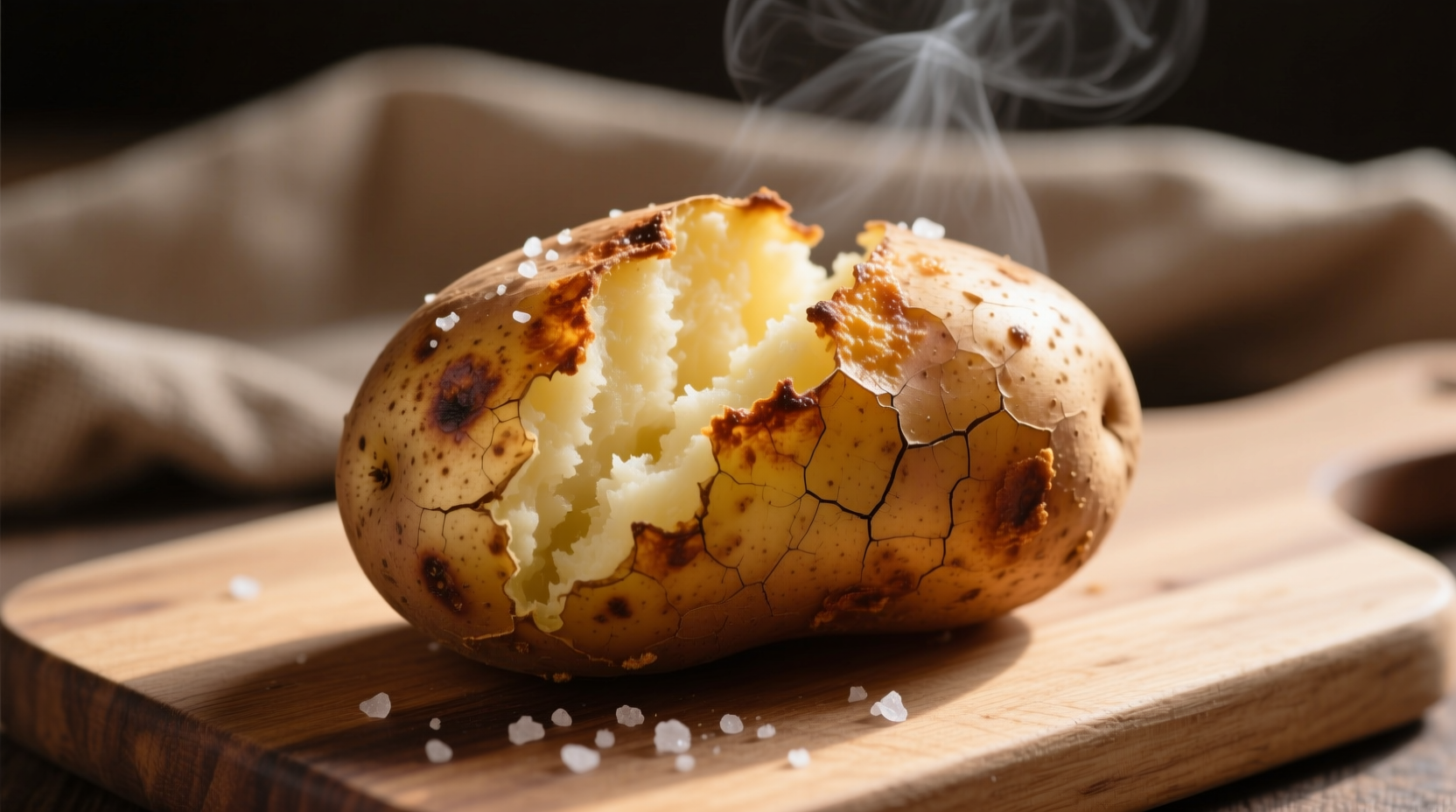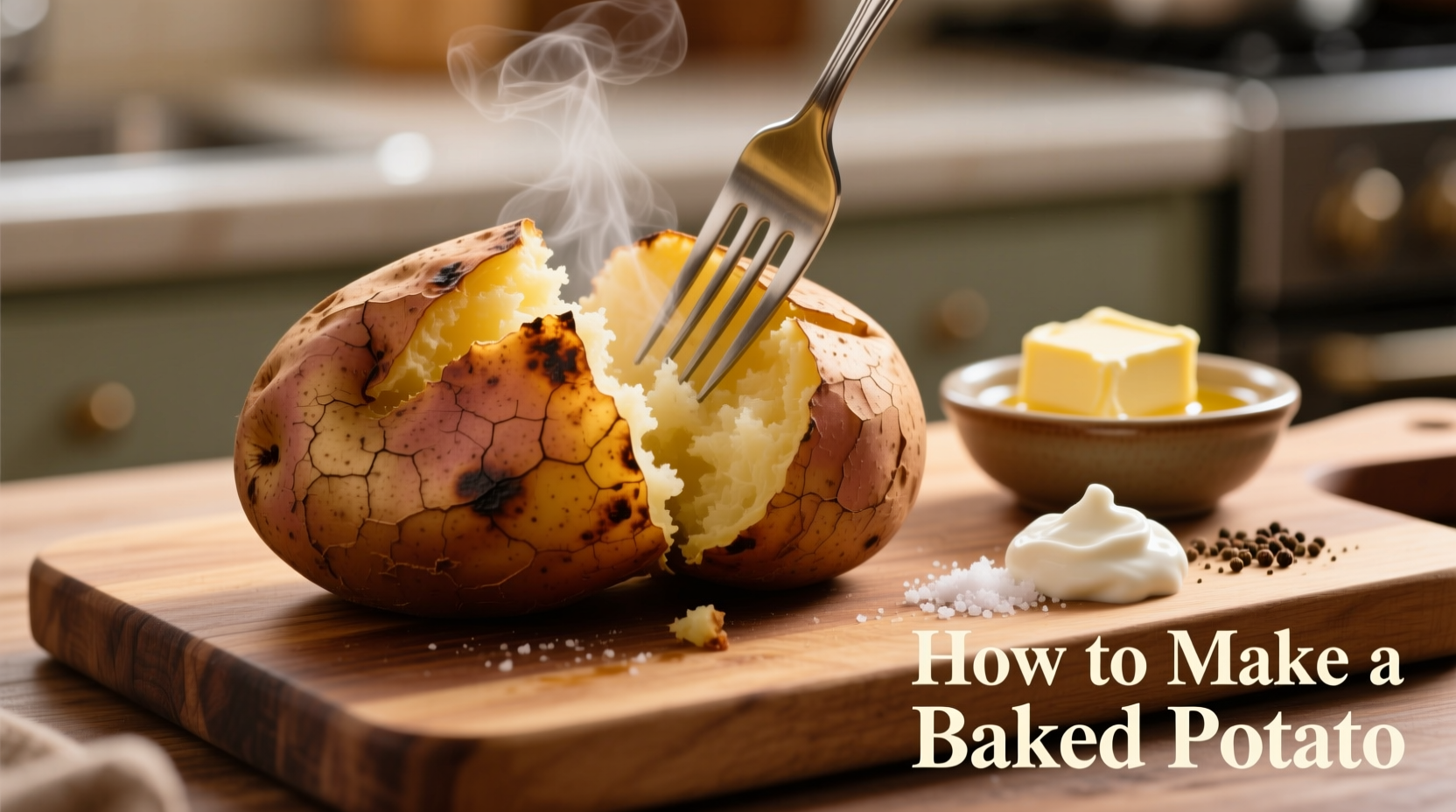Nothing beats the comforting simplicity of a perfectly baked potato. As a culinary professional who's taught thousands of home cooks, I've discovered that mastering this basic technique unlocks endless meal possibilities. Whether you're preparing a quick weeknight dinner or elevating a special occasion, understanding the science behind baking potatoes ensures consistent, fluffy results every time.
Essential Tools and Ingredients
Before you begin, gather these kitchen essentials:
- Russet potatoes (ideal for baking due to high starch content)
- Sharp knife or fork for piercing
- Baking sheet or oven rack
- Parchment paper (optional)
- Olive oil or melted butter
- Kosher salt
| Tool | Why It Matters | Professional Alternative |
|---|---|---|
| Russet potatoes | Higher starch content creates fluffy interior | Yukon Gold for creamier texture |
| Meat thermometer | Guarantees perfect doneness (205-210°F) | Fork test for beginners |
| Oven rack positioning | Middle rack ensures even heat distribution | Rotating pan halfway through |
The Foolproof Baking Process
Preparation: Setting Up for Success
Start by thoroughly washing potatoes under cold running water, scrubbing away any dirt with a vegetable brush. This critical food safety step removes potential contaminants from the potato skin. According to the USDA Food Safety and Inspection Service, proper washing reduces risk of foodborne illness from produce.
Next, pierce each potato 4-6 times with a fork or sharp knife. This essential step prevents dangerous steam buildup that could cause potatoes to explode in the oven. The National Center for Home Food Preservation confirms that piercing allows steam to escape safely during cooking.
Seasoning and Baking: The Critical Steps
Rub each potato with 1 teaspoon of olive oil and sprinkle generously with kosher salt. The oil helps create a beautifully crisp skin while the salt enhances flavor and texture. Place potatoes directly on the middle oven rack with a baking sheet on the rack below to catch any drips.
Bake at 400°F (204°C) for 45-60 minutes, depending on potato size. Larger potatoes (8+ ounces) typically require 55-60 minutes. The optimal baking temperature range of 375-425°F creates the perfect balance between crispy skin and fluffy interior, as confirmed by culinary research at the American University Food Studies Program.
Determining Doneness: Beyond Guesswork
For guaranteed perfect results, check internal temperature with a meat thermometer. Potatoes reach ideal doneness at 205-210°F (96-99°C). At this temperature, starch granules have fully absorbed water and ruptured, creating that signature fluffy texture. Without a thermometer, squeeze potatoes gently with oven mitts—they should give slightly when done.
Common Mistakes to Avoid
Many home cooks make these critical errors that compromise results:
- Skipping the pierce step - creates explosion risk
- Wrapping in foil - steams rather than bakes, creating soggy skin
- Underseasoning - salt needs time to penetrate during baking
- Incorrect oven temperature - below 375°F yields dense texture
Serving Your Perfect Baked Potato
Once baked, slice potatoes lengthwise and fluff the interior with a fork. For restaurant-quality presentation, add a small pat of butter that melts into the fluffy interior. Classic toppings include sour cream, chives, and bacon bits, but don't be afraid to experiment with creative options like chili, broccoli and cheese, or roasted garlic aioli.

Storage and Reheating Tips
Store leftover baked potatoes in the refrigerator for up to 4 days. The FDA Food Code recommends cooling potatoes to room temperature within 2 hours before refrigeration. For best reheating results, wrap in damp paper towel and microwave for 2-3 minutes, or warm in a 350°F oven for 15-20 minutes to maintain crispy skin.
Frequently Asked Questions
How long does it take to bake a potato at 400 degrees?
Russet potatoes typically require 45-60 minutes at 400°F (204°C), depending on size. A medium potato (6-8 ounces) usually takes 50-55 minutes. The most reliable indicator is internal temperature—potatoes reach perfect doneness at 205-210°F (96-99°C).
Should I wrap potatoes in foil before baking?
No, wrapping potatoes in foil creates steam that results in soggy skin rather than crispy texture. Professional chefs recommend baking potatoes directly on the oven rack for optimal results. Foil can be used only during the last 10-15 minutes if you prefer softer skin.
Why do you need to poke holes in potatoes before baking?
Piercing potatoes allows steam to escape during baking, preventing dangerous pressure buildup that could cause them to explode. The USDA recommends piercing potatoes 4-6 times with a fork for safe baking. This critical food safety step shouldn't be skipped.
Can you bake potatoes at a lower temperature for longer?
While possible, baking below 375°F typically yields denser texture. The ideal temperature range is 375-425°F. Lower temperatures (325°F) require 75-90 minutes but often produce less fluffy results. For best texture, maintain 400°F for the standard 45-60 minute baking time.
How do you know when a baked potato is done?
A perfectly baked potato reaches an internal temperature of 205-210°F (96-99°C). Without a thermometer, squeeze gently with oven mitts—it should give slightly. The skin should appear crisp and slightly wrinkled, and a fork should slide in easily with no resistance.











 浙公网安备
33010002000092号
浙公网安备
33010002000092号 浙B2-20120091-4
浙B2-20120091-4